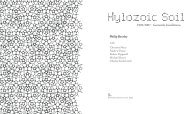The Inner Studio - Riverside Architectural Press
The Inner Studio - Riverside Architectural Press
The Inner Studio - Riverside Architectural Press
You also want an ePaper? Increase the reach of your titles
YUMPU automatically turns print PDFs into web optimized ePapers that Google loves.
PART THREE | INNER RESOURCES<br />
with our own psychological reality. <strong>The</strong> built world becomes<br />
detached from us and literally rises above the concerns of most<br />
human beings. What we don’t recognize, we cannot heal. What<br />
hope is there for the built world when we ignore our own nature?<br />
Architecture is no stranger to physical shadow, a condition in<br />
which shade is cast by the interception of light. It is widely understood<br />
that “darkening” has always been part of the design palette.<br />
Shadow is exalted in the reveal, a type of construction detail in<br />
which a joint or seam between materials is hidden by recessing a<br />
surface. <strong>The</strong> reveal hides by casting a shadow. A similar idea can be<br />
found in the scotia–a Greek term for shadow–a concave molding<br />
that casts a strong shadow at the base of a column. Its effect is to<br />
allow the column to appear to float by obscuring its connection<br />
with the ground.<br />
<strong>Architectural</strong>ly, the use of shadow is as powerful as light itself,<br />
and these two are obviously in dialogue. At the start of a performance,<br />
a darkened room is aroused by a spot of light. Often, at the<br />
point of entry to a religious building, we meet a shadowy space<br />
before moving through to an expansion of well-lit space. <strong>The</strong> darkening<br />
of a space helps to create a kind of compression before<br />
progressing into a sense of expansion accompanied by light.<br />
Physical shadow can also make an interior seem unwelcoming or<br />
frightening. Horror films are drawn to climax in dark basements and<br />
shadowy attics and there are whole parts of cities in which shadowy<br />
things are known to occur in contrast to the bright city lights.<br />
According to Rudolph Otto, darkness in our religious buildings,<br />
along with silence and emptiness, is necessary to create the physical<br />
container for a sense of holiness. <strong>The</strong> darkness of narrow streets<br />
provides the context for the unexpected emergence into bright,<br />
sunny, public space. A dramatic indication of our modern refusal<br />
to consider the meaning of the shadow is found in the exaggerated<br />
level of lighting that now fills our cities and shopping environments.<br />
While issues of safety and merchandising drive some of<br />
these lighting levels, our cities remain unsafe because our own<br />
psychological shadow isn’t factored into place making. We are<br />
afraid of our own darkness. Annihilating the shadow paradoxically<br />
means there can be no sense of security. We need to get to know<br />
99





